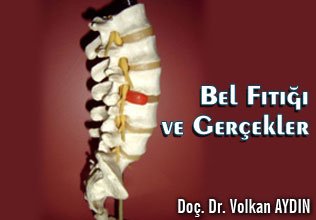
There are 5 vertebrae called L1- L5 in our lower back. Between these vertebrae, there is a structure consisting of two different layers called discs. Annulus Fibrosus, the outer layer of the structure called disc, is hard, whereas the inner layer, Nucleus Pulposus, is softer and has a gelatinous consistency. The task of the discs located between the vertebrae is to distribute the load on them and work as a kind of shock absorber. In addition to its contribution to movement and load-bearing feature, it also acts as a protector for the spinal cord and nerve roots, like other parts of the spine.
For various reasons; The inner layer, the nucleus pulposus, is pushed back by pushing the outer layer or coming out of the tear in the outer layer due to reasons such as lifting heavy weights by leaning forward, postural disorder, familial predisposition, the waist and abdominal muscles not being strong enough, and the wear of the outer layer, the annulus fibrosus, with advancing age. As a result of the correct displacement, pressure on the nerves going to the spinal cord and legs, a condition called disc herniation-lumbar hernia occurs.
Lumbar Hernia Findings:
1. Typically, patients with lumbar hernia should have low back pain and a very high rate of accompanying leg pain. Leg pain is such an important finding for lumbar hernia that the rate of lumbar hernia presenting only with low back pain without leg pain is 1%
2. Numbness and/or weakness in the leg and foot
3 Weakness in both legs, urinary-fecal problems and sexual dysfunction, which rarely develops suddenly in large midline hernias (It is very rare and requires urgent surgical intervention- in the first 24 hours-)
The most important thing for us Neurosurgeons is the pinched nerve. It is weakness that develops in the thigh and/or foot according to the level of
The most important factor affecting our decision for surgery is whether there is weakness or not.
Treatment:
Medication and short-term bed rest
Physical Therapy
Surgery
85-90% of hernia patients They are relieved with the 1st and 2nd treatments and there is no need for surgical intervention.
Surgical intervention is required for patients who are not relieved by these treatments, especially for patients whose power loss does not increase or decrease, or for patients whose examination findings are normal but their pain does not go away with other treatments.
Surgical treatment options;
–Open Discectomy: It is a form of surgery that was used in the past, it has been abandoned today.
–Intradiscal Interventions: These are the interventions that are known as laser, needle, closed surgery among the people and which are used to reduce the pressure there by creating small fragments in the nucleus pulposus with laser, radiofrequency waves, etc., by entering into the disc with a needle. Only 5% of lumbar hernias are suitable for this intervention and may benefit. It is thought that the patients who are suitable for this intervention are those who can improve with drug therapy and physical therapy.
— Microdiscectomy: Today, it is considered the gold standard in hernia surgery in every country of the world. The herniated area is reached with a very small incision and the herniated disc material is removed with the help of a microscope. The operation takes about 20-30 minutes in experienced hands and the patient can be discharged the same day or the next morning, there are no stitches on the skin surface. The use of a microscope eliminates the risks that may occur.
After lumbar hernia surgeries, 5% recurrence or recurrence of hernia can be seen. In order to further reduce this risk, I recommend that overweight patients lose weight, start doing the exercises your doctor recommends one month after the operation, and take care of your posture.
Associate Professor Volkan Aydın
Neurospinal Cord Nerve Surgery Specialist

